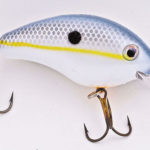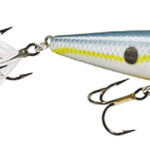
This sport is growing rapidly because it is so much fun and surprisingly productive.
This month, I’ll return to the Red River at Shreveport to fish for bass. Generally in June, the river begins to go down and stabilize, and the bass start their summertime pattern. The water’s warm, the bass will be active and the spawn has ended. The bass are hungry and starting to feed up to replace the body mass they’ve lost during the spawn.Depending on the water level, you may catch bass in the backwaters, as well as on the main river, if the river starts to clear up. The jetties are another productive place for bass.
My game plan for the day will be to start fishing the backwater areas in the morning with a white or black Strike King buzz bait, depending on the amount of sunlight on the day I’m fishing. I’ll also fish the Spit-N King. I’ll cast both these baits around visible cover, like laydowns and lily pads, and I’ll expect to get that first top-water, early-morning bite.
On some days, I’ll stay in the backwaters of the Red River all day if I’m continuing to catch bass. There’s a tendency to catch bigger bass in the backwaters than I’ll catch on the main river. If we have cloudy, low-light conditions on the day I’m fishing, I may be able to get that topwater bite all day because the water temperature usually will stay in the 80-degree range.
My next stop will be that last 1/4-mile coming out of the backwater, headed toward the main river channel. Most of the bass that live in the river have migrated into the backwater places during the spawning season. If the river is somewhat dirty, often the bass will hold in that last 1/4-mile of backwater before you reach the main river. That’s why I’ll start working from 1/4-mile inside the backwater.
As the sun rises and the weather warms, I’ll move out to deeper structure, and fish Strike King crankbaits, primarily the Series 4S, a shallow-running, square-billed crankbait. I’ll try to run that crankbait around laydowns and logs. The 4S has a lot of rattle. It’s a shallow-running, wide-wobbling bait, and I prefer it in chartreuse/black and sexy shad.
If the water’s clear, and I think the bass may be holding a little deeper, I’ll switch to a Series 4, which is the same style and type of lure as a 4S but runs 4 or 5 feet deeper. Or I’ll fish a Series 3, which is a smaller crankbait that runs 5 or 6 feet deep.
Many of the backwater places on the Red River have jetties in their mouths. When I reach those jetties, I’ll use those crankbaits to fish along the jetties out to the main river. Chartreuse and sexy shad are two colors that are hard to beat on the Red River this month when fishing crankbaits. Actually, those two colors should produce bass anywhere in the United States during June.
Anytime I’m fishing a crankbait, I like to crash it into structure and have it deflect because 90 percent of the time, the bass will take the crankbait when it bounces off the cover. There are two schools of thought on how to retrieve the crankbait when it crashes into cover. One is to pause the bait like it’s been injured from hitting the cover, and the other is to speed up the bait. I sort of combine these two types of fishing.
If I’m fishing rocks, and the bait hits the rocks, I’ll speed it up like the crankbait is an injured baitfish. In real life as the baitfish hits the rock, it will see a bass about to eat it, and the baitfish will want to escape quickly. However, if I’m fishing around wood, and the crankbait hits the wood, a log or a limb, I’ll hesitate the bait long enough to let it ride up over the wood and then speed up the retrieve.
Once I reach the ends of the jetties coming out of the backwater areas, I’ll start running the river and fishing jetties and riprap. The Red River has rock walls and rock jetties with some running parallel to the river channel and some perpendicular to the river. The current generally determines on which type of rock bass will hold. With a strong current, the bass usually will position on obvious structure and rocks that break the current. I fish both types of rocks to determine how the bass are positioned. On some days, the bass may want to position on the jetties that break the current, or they may want to hold on the riprap that runs parallel to the river channel.
This month, fishing on the main river is a bass fisherman’s dream since most of the time the bass will be holding on obvious cover that any bass fisherman can recognize. I mainly look for some type of current break that the bass can hold behind and wait on baitfish to come by.
During June, I expect to catch 10 to 20 bass every time I fish the Red River. We really haven’t gotten into the dog days of summer during June, so the fishing should be really good. Generally at this time of year, if you catch a 4- or 5-pound bass, that’s considered a good-sized fish. But you also may catch good numbers this month at the Red River with these techniques and lures.




